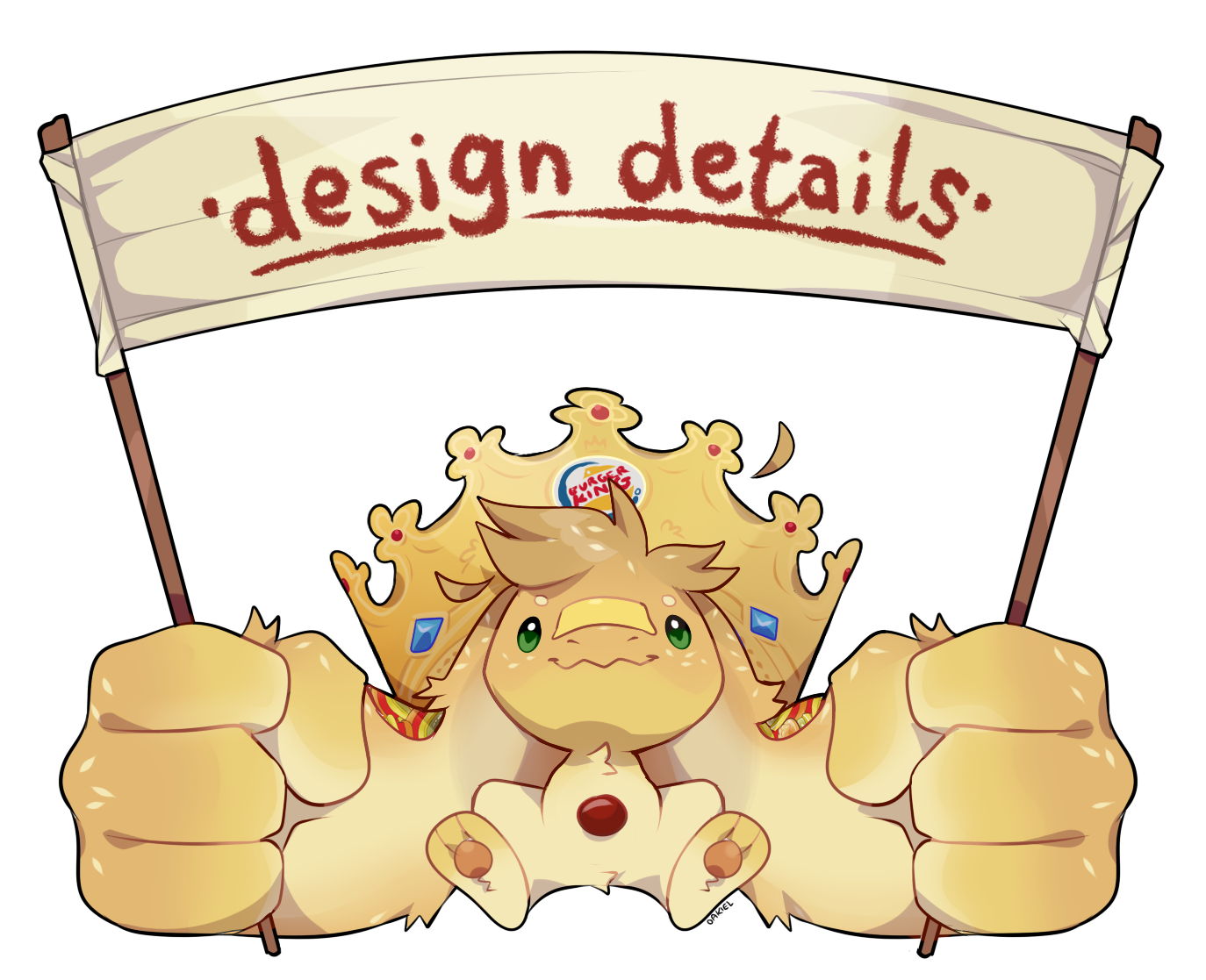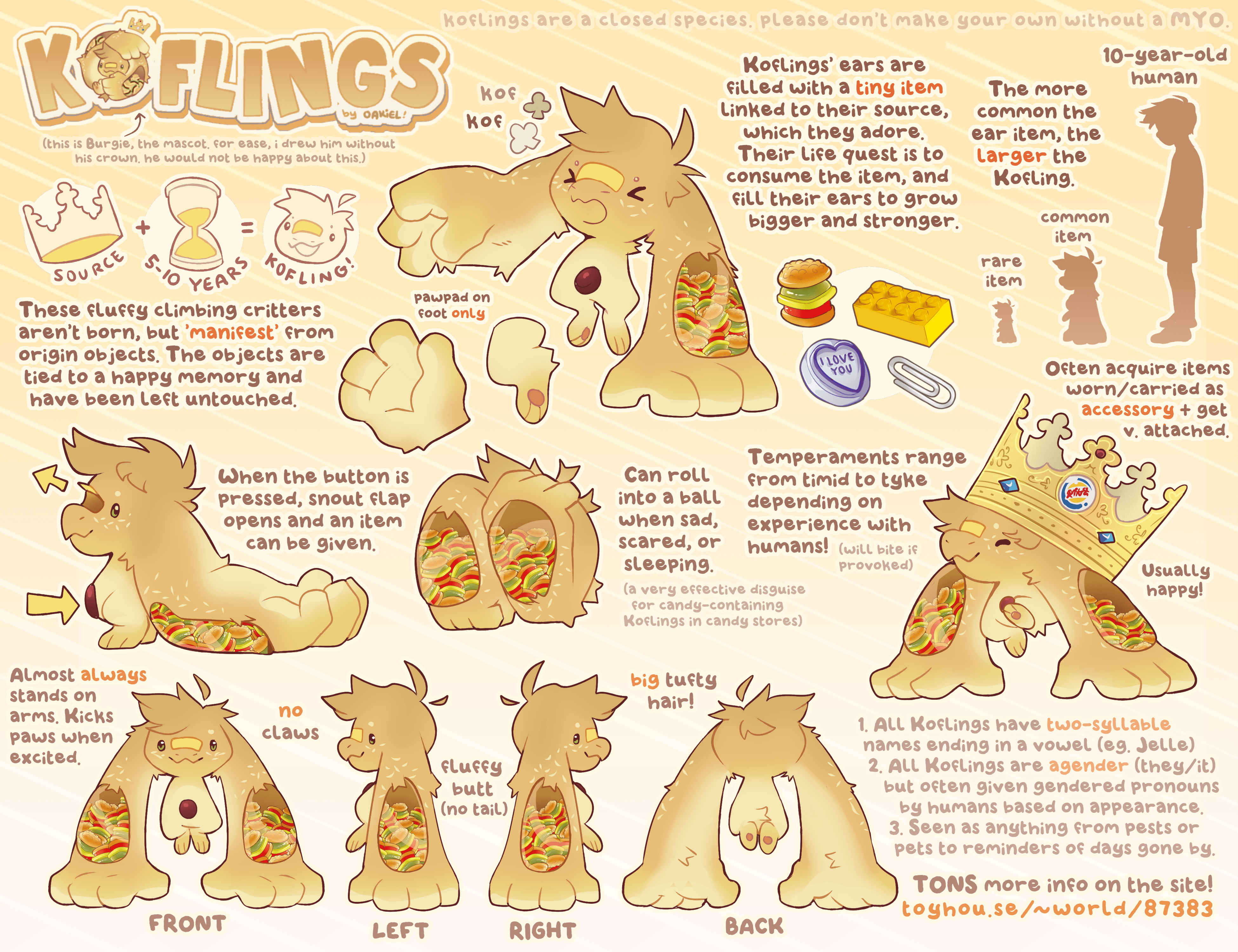
Koflings are a special kind of critter - they aren’t born, but come to exist from forgotten objects, a process that occurs over a period of years, called ‘manifesting’. This can happen to any object that has some kind of memories attached to it and has been left untouched for a long period of time. The object they come from, known as their source or origin item, is always smaller than, say, a single bed; they never manifest from larger objects. Since their origin items must be left untouched, Koflings are often found in attics, basements, and abandoned buildings, so often are in contact with dust and dirt, giving them all the same little cough which formed their namesake.
Koflings do not age or grow in the traditional sense. Instead, their hollow arms are filled with a specific item which the individual Kofling is drawn to. These items reflect their source item in some way - such as a burger gummy for Ype, whose origin item is a cardboard Burger King crown. The item is consumed by swallowing it whole via mouth, and the Kofling is driven to seek out more of the item in any way it can. The more ear items they consume, the larger and more energetic the Kofling becomes.
When the button on their bellies is pressed in, a flap above the snout opens up, and the creature can decide to raise their arm and deposit an item from their stash out the flap to give to someone. This is the ultimate sign of affection, respect, and trust, since Koflings adore their ear item and they can be quite difficult to come across. Koflings whose ear items are rare (such as jewels) are therefore smaller and weaker than those with a common item (such as Lego bricks).
Koflings only die if their source item is destroyed, or if the memories attached to it are forgotten (for example, the person whom the events happened to passes away, or is affected by dementia). They are not predators, since their ‘food’ is inanimate, and are not prey, since mammals know intrinsically not to eat them - their inner items would cause choking and digestive distress.
Besides the coughing, Koflings also tend to make noise from the items inside them rattling or bouncing about as the creatures climb, jump, and run around. They communicate through high-pitched yips, not unlike puppies, and this cacophony of noises has often annoyed homeowners who see them as a nuisance. Pest control companies are hired to remove the Koflings in a humane manner, but this is easier said than done - they are fast, and can bite if provoked.
Some Koflings are more human-friendly than others, and every one is different in temperament based on their source item, environment, and experience with humans. The easiest way to relocate a Kofling is to relocate their source item, as they will follow it with intense loyalty. However, this is still a challenge since they protect it fiercely from what they perceive to be threats.
Koflings can form close bonds with humans if they have the right temperament. They form these bonds easier with children, who often have the required energy to keep them entertained, and have stronger memories than adults. They naturally form the most intense bond with the human whose memory manifested them (typically the owner of the source item) if said human is available. Then, they will protect the human just as they protect their origin item.
That being said, Koflings don’t make the perfect pet. Most of these critters are incredibly free-spirited, energetic, rambunctious, and a bit destructive if placed in a household environment. That doesn’t stop some more patient people from considering a Kofling to be part of their family.
Regular Koflings only ever manifest from positive memories. For example, Ype’s cardboard crown was from his owner’s 10th birthday party with his best friends, having a blast at a Burger King after a trip to the swimming pool. They can also be less significant moments, such as a favourite spoon or a candle received as a gift. Typically the memories are from younger days since these are the strongest.
When a Kofling is formed from a sad, scary, or otherwise unpleasant memory that is best forgotten, they are known as Dark Koflings. These are very rare, as most traumatic memories are suppressed. They are dark in colour, have no eyes, and are filled with nasty items. They are always aggressive. Dark Koflings are currently a WIP and cannot be made as MYOs or guest adoptables.
Normal Koflings are also only ever formed of man-made, non natural objects and can only have these as ear items too. Items may be edible (ie. burger gummies) but cannot decay (ie. burgers), otherwise the Kofling would become very sick with the rot and mold inside them.
Similarly, Koflings whose source and ear items are natural, such as flowers, leaves, or nuts, are also a different and distinct branch of the species with their own traits and behaviours which will be developed in the future. Therefore, they also cannot currently be made as MYOs or guest adoptables.
Koflings are always agender, since they are not born and do not breed, so would typically be they/them or it/its. However, since many Koflings are found around humans, they also are given genders (he/him or she/her) by their owners/companions/enemies. Koflings may also be given nicknames by their humans. Nicknames don't have to adhere to the below naming conventions.
The convention for a Kofling's real name is as follows: they are always two-syllable and end in a vowel sound. Typically this involves an -a, -e, -o, -u, -i, or -y ending. These can be long or short, with as many consonants as desired. Since these names are also human-given, they can be existing words, in the style of any culture or language. Some examples are Ype, Lanka, Orso, Rummy, Dingo, Pika, Baby, and Lyra.

As for the physical features of a Kofling, they have thick, strong arms that are their main method of moving around. They are great climbers and very quick. The arms are thicker towards the bottom with the hands being the largest part. Each hand has three fingers and a thumb. Koflings hear through sensitive palms which can pick up vibrations from nearby surfaces. Their feet are rabbit-like and, when a Kofling is stood on their arms, they dangle in the air. Koflings kick their feet to express excitement.
Common Koflings are almost always fluffy with large, spiky tufts of hair on their head and shorter stray tufts of fur about the body. The markings are always based around their source item, and as such, they can have very interesting appearances, often with unusual textures. Despite this, they rarely have busy or striking markings, typically featuring large blocks of colour or whole-body patterns instead. The main visual points of interest are the ear windows filled with intricate contents, so a minimal body design helps balance out this area of detail.
The snout flap and belly button can be different colours, although Koflings usually have a set palette meaning these will both match the colour of something else on their body. Eyes are small and beady, and quite far apart to make room for the rounded rectangle of their nose flap. They always have short rounded snouts with large visible pointed teeth, but normal Koflings tend to be happy and smiling (so that’s a little less threatening at least!).
Ear windows can vary slightly in shape and size, but not position. They are always at the front of the forearm section. They are always rounded, but some might be wider at the bottom, top, or in the middle. Ears can be more or less filled than when shown in their original reference, since they are constantly on a quest to consume more of their ear item. They are often seen sporting a (typically stolen) household object, accessory, or item of clothing, usually linked in some way to their ear or source item, which becomes their signature look. Many Koflings are very attached to their accessories and will not willingly remove them.
